| |
Some Iroquois Artifacts (continued)
Click on images to enlarge

|
[Slide 31] The preservation of wooden objects, such as the lower end of this palisade post, is rare.
Bottom of a Onondaga Iroquois palisade post made from a hemlock sapling, c.1600, on display at the Iroquois Village Model exhibit at the New York State Museum. When you see it there, notice the cut facets on the lower pointed end, probably made with a European iron trade axe. Height: 19 ½ inches. Onondaga County, NY. |

|
[Slide 32]Although artifacts of baked clay are the most numerous objects found by archeologists on an Iroquois site, rarely do they include toys such as this little animal.
Oneida Iroquois clay toy animal, c.1450-1500. Length: 2 inches. Bemis site, Otsego County, NY. |
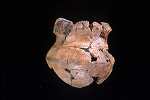
|
[Slide 33] Despite its small size, this beautiful miniature pot was probably not a toy, but had some special use.
Reconstructed miniature Mohawk Iroquois clay pot, c.1525-1550, beautifully made and decorated. Height: 4 inches. Garoga site, Fulton County, NY. |
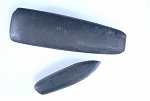
|
[Slide 34] Polished stone axes, such as those shown here, once had sturdy wooden handles. They were men's tools, used to cut down trees and in woodworking activities.
Mohawk Iroquois polished stone axes, c.1500-1600. The larger axe shown in side view, has its cutting edge, or bit, to the left; an edgewise view of the small axe shows that it had been sharpened many times before being discarded. Lengths: about 5 1/8 inches, and 8 ¼ inches. Fulton County, NY. |
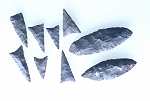
|
[Slide 35] As hunters and warriors, Iroquois men also made triangular-shaped arrowpoints and leaf-shaped knives from chert or flint, a hard brittle mineral found in outcrops of local bedrock.
Mohawk Iroquois triangular-shaped, chert [flint] arrowpoints at left; at right, chert [flint] leaf-shaped knives, once fitted with wood, bone, or antler handles, c.1500-1600. Arrowpoints range in length from about 1 to 1 ¾ inches. Length of the knives are about 2 3/8 and 2 ¾ inches. Fulton County, NY. |

|
[Slide 36] Animals provided meat and skins; the latter became robes and blankets or tanned buckskin for clothing. Bones and antlers became weapons, tools, and ornaments.
Mohawk Iroquois antler and bone tools, c.1500-1600. Antler "punches" [right] used to chip tools and weapons from chert; four bone awls [bottom center] used to punch holes in buckskin or other relatively soft materials; three bird-bone beads [top center]; and, three deer toe bones which have been ground and polished into "tinkling cones" or "rattles" [top left], which in use, were fastened to a buckskin band tied just below the knee. Length of the longest awl, 7 inches. Fulton County, NY. |

|
[Slide 37] Like pumpkins, squash, beans, and corn or maize, tobacco was another domesticated plant raised by the Iroquois. Men smoked it in pipes of a variety of forms and materials, including wood, bone, antler, stone, and baked clay, as shown here.
Iroquois ceramic [baked clay], trumpet-bowl smoking pipes, c.1450-1500. Lengths: 4, and 5 ¾ inches. Jefferson County, NY. |
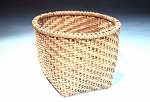
|
[Slide 38] Little of what was made of perishable materials by Iroquois people 400 years ago has survived. Baskets like this splint basket used in preparing corn for food, must have been very common in Iroquois households.
Seneca Iroquois ash splint hulling basket, c.1900. Used in the preparation of corn soup. Height: 11 ½ inches. Western New York State. |
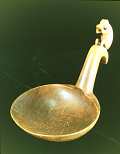
|
[Slide 39] What we know about these perishable artifacts, which one might call "softwares," comes from Iroquois oral tradition, European descriptions, or from objects - like this wooden ladle with a squirrel carved on its handle - that were collected directly from Iroquois people during the past 200 years.
Seneca Iroquois wooden ladle decorated with a squirrel on the handle, c.1850. Height: 7 inches. Tonawanda Band of Seneca Indians, western New York State. |
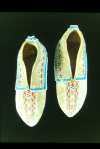
|
[Slide 40] Like this pair of decorated buckskin moccasins, various sources allow us to put ourselves into Iroquois "shoes" and glimpse Iroquois life of 400 years ago.
Seneca Iroquois glass bead and porcupine-quill decorated buckskin moccasins, c.1850. Length: 11 inches. Western New York State. |
Sources:
21: Iroquois clay pots in Artifacts of the Iroquois Longhouse, c.1450-1600, A Mohawk Iroquois Village. New York State Museum, Albany, NY.
22-34: Objects exhibited in Artifacts of the Iroquois Longhouse, c.1450-1600, A Mohawk Iroquois Village. From the collections of the Anthropological Survey, New York State Museum, Albany, NY.
34-37: Iroquois archeological objects in the collections of the Anthropological Survey, New York State Museum, Albany, NY. Although these artifacts are not on display, similar objects are exhibited in Artifacts of the Iroquois Longhouse [c.1600], A Mohawk Iroquois Village.
38-40: Iroquois ethnological objects, or artifacts collected directly from the Iroquois since 1850 and in the collection of the Anthropological Survey, New York State Museum, Albany, NY.
|
|









